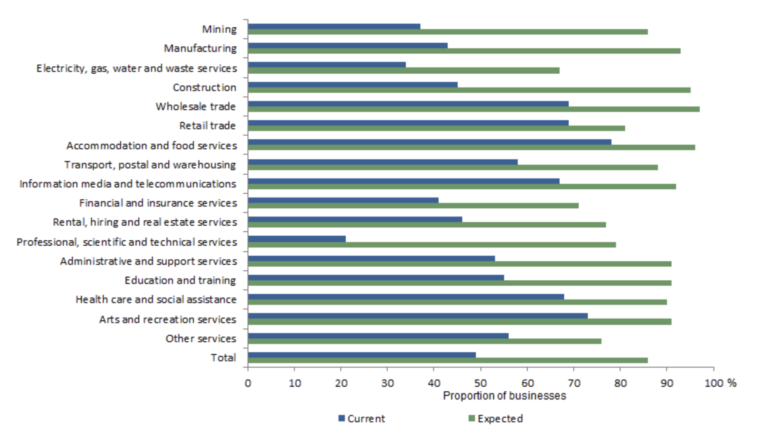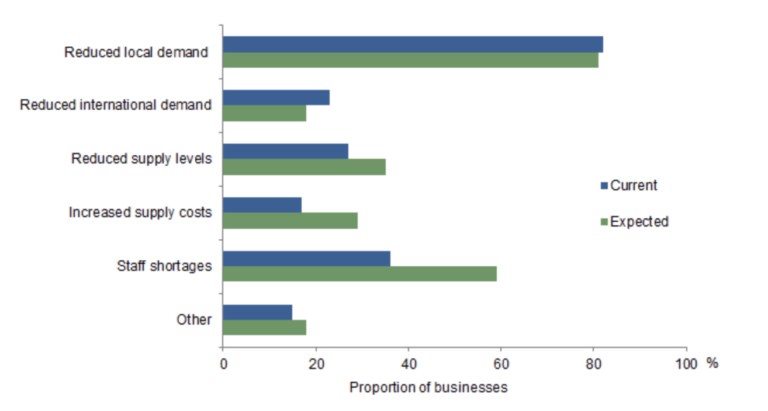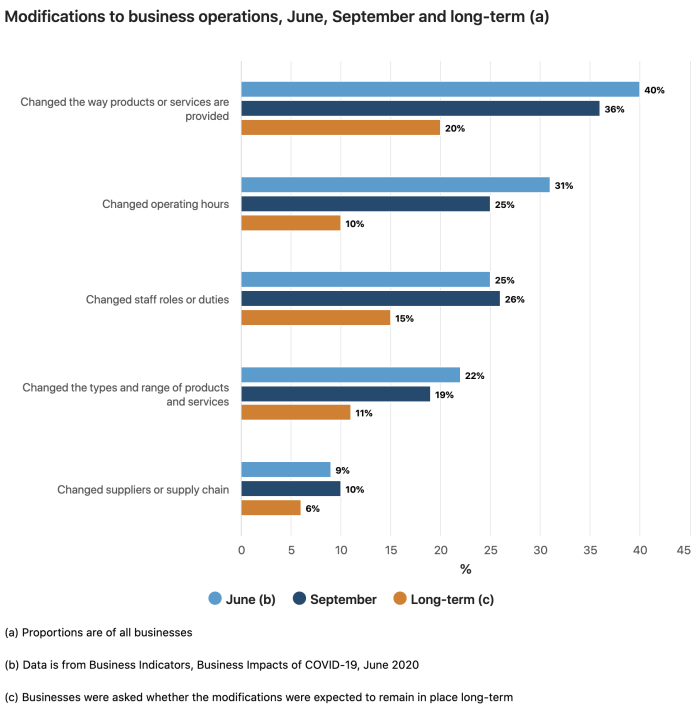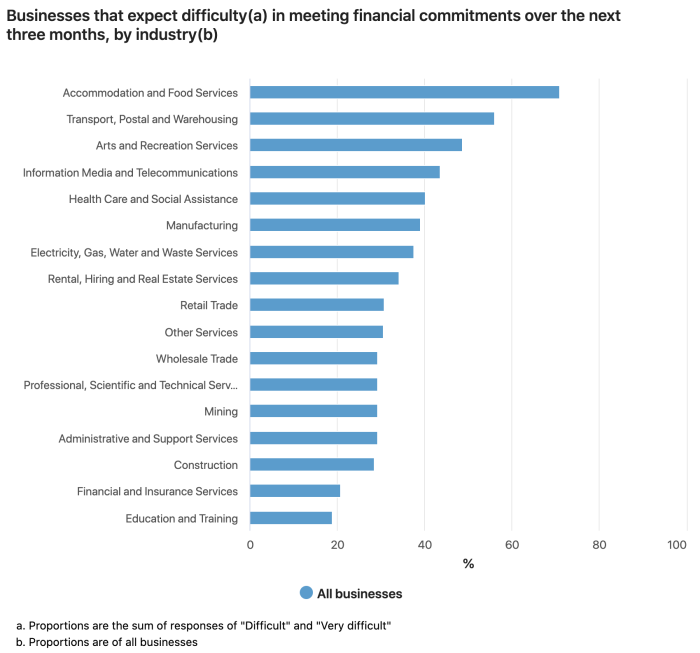Coronavirus and the impact on Australia's economy
Australia has not suffered the same way many other countries have at the hands of COVID-19, however the stringent restrictions that stifled regular business activity is likely to be felt by companies long after things return to some semblance of normal.
Impacts of COVID-19

Adverse impacts of the pandemic include reductions in local demand, which was the most common impact (82%) experienced as a direct result of non-essential travel restrictions and social distancing which was introduced to help ‘flatten the curve’ and limit the virus’ spread across the country. This, incidentally, has led to a number of businesses becoming insolvent and ultimately facing coronavirus company liquidation or company administration as an option.

According to the ABS’ March figures, more than a third of affected businesses also experienced staff shortages (36%). Due to the ongoing travel and interaction restrictions, 59% of businesses expected to experience staff shortages in coming months.
Australia’s Accommodation & food services sector was the most affected by adverse impacts of COVID-19, with 78% of businesses (or more than three quarters) already reporting impacts and 96% of businesses reporting that they expected impacts in coming months.
In March, cash flow was a prominent issue for businesses as the pandemic forced them to adopt new behaviours to avoid insolvency and coronavirus company liquidation. Without a consistent stream of customer spending, or new projects or client contracts, two thirds (66%) of Australian businesses reported a reduced turnover or cash flow.
The fallen cash flows made it difficult for businesses to maintain a steady rate of operations. Nearly half of businesses (47%) were forced to make changes to their workforce arrangements as a result of COVID-19. These arrangements include:
- Temporarily reducing or increasing staff working hours;
- Changing the location where staff worked (including working from home); and
- Placing staff on leave.
Many businesses were also forced to restructure their business model to stay afloat. Two in five businesses (38%) changed how they deliver their products or services, including shifting to online services, and over a third of businesses have renegotiated their lease and rental arrangements and a quarter have deferred loan repayments.
The ongoing pandemic - how coronavirus continues to affect businesses
Since the initial outbreak, Australia has seen more than 27,000 coronavirus cases, as at October 2020 since January 2020. ABS figures in September 2020 revealed that almost two-thirds (64%) of all businesses reported that they were operating under modified conditions. Businesses have been forced to change the way they do things, from changing their service or the way customers receive products, to sacking staff and altering business hours to keep operating expenses down. The ABS said that the most common types of modifications in place were changes to the way product or services are provided (36%), and changes to staff roles or duties (26%).

With personnel changes and income shortages, Australian businesses have been forced to acknowledge that they could not continue operating the way they used to. In May 2020, the ABS revealed that 72% of businesses had less income as a result of COVID-19. This meant that many businesses were forced to seek additional funds to stay afloat – one in ten, in fact. Of those businesses that sought additional funds, more than half of them (57%) borrowed from banks or financial institutions, while others sought out personal lines of credit or savings or sourced funds from other businesses.
Recession
Perhaps unsurprisingly, economic pundits foresaw a recession on Australia’s horizon, and in mid-2020 Treasurer Josh Frydenberg conceded Australia would enter into a technical recession upon release of the June quarter GDP data.
Australia’s GDP fell 0.3% in seasonally adjusted, chain volume terms in the March quarter 2020 and growth slowed to 1.4% through the year.
Recessions are typically classified as an outcome resulting from negative GDP growth for two consecutive quarters.
ABS Chief Economist Bruce Hockman said, “this was the slowest through-the-year growth since September 2009 when Australia was in the midst of the Global Financial Crisis and captures just the beginning of the expected economic effects of COVID-19.”
Social distancing and reduced business activities have certainly affected the country’s economic health, but a timeline for a vaccine and the projected longevity of the pandemic are not yet confirmed, which makes it difficult to tell if a recession will occur as a passing moment or have severe lingering effects on the country. It was perhaps best said by Sydney Morning Herald Senior Economic Writer Jessica Irvine on March 13, 2020:
“What really matters is if the economy loses so much momentum that firms start to anticipate a sustained period of revenue shrinkage. In such a world, companies may decide to lay off their workers in a bid to avoid going insolvent, or they may just go under, regardless.
“If lots of companies are downsizing at the same time, sacked workers may find it hard to pick up another job. If they can’t get another job, they can’t pay their mortgages. If they can’t pay their mortgages, the bank might sell their homes.
“If that happens to enough people, home values may fall. That could lead even more people to spend even less, forcing even more job losses. And so forth.”
Companies that entered external administration, like coronavirus company liquidation, across Australia 2019-20. Released September 2020 by the Australian Securities and Investments Commission.
Looking ahead
Restrictions have gone back and forth in terms of leniency across Australia. In several states, people have been gradually returning to work and taking tentative steps toward social gatherings. Despite many states recording new cases, the amount of cases has decreased in several areas and plans are in place to lift even more restrictions with careful optimism.
However, the impact on businesses after months of restricted activity has left many to face insolvency and coronavirus company liquidation.
More than a third (35%) of Australian businesses expect to find it difficult or very difficult to meet financial commitments over the coming months.
The ABS found that small businesses were almost twice as likely to report that they expected to find it difficult or very difficult compared to large businesses (35% compared to 18%).
ABS Head of Industry Statistics John Shepherd said, “41% of businesses reported that revenue had fallen over the last month and 22% had an increase in operating expenses.
“In addition, 28% of businesses expected to decrease in revenue over the next month.”
Shepherd also said that almost a quarter of businesses (23%) reported they had decreases or cancelled their actual or planned capital expenditure compared to three months earlier.
“Businesses reported that their decisions related to expenditure on capital were significantly influenced by uncertainty about the future state of the economy (59%), and future expected customer demand for their products or services (40%).”

It seems the economic effects of COVID-19 will be felt for many months to come and businesses will need to be vigilant to avoid becoming insolvent. However, months of isolation and stringent social distancing have cleared the path for optimism and Australia has started to look to the future. In several states, people have been gradually returning to work and taking tentative steps toward small social gatherings. Several government restrictions are still in effect and across Australia but plans are in place to create a roadmap to recovery.
All data, graphs and statistics were sourced from the Australian Bureau of Statistics and its range of existing and ongoing statistical products produced exclusively to measure the impacts of COVID-19.
Are you facing coronavirus company liquidation?
If coronavirus has made your business insolvent, you may need to enter into company liquidation. This involves an independent and suitably qualified liquidator taking control of your business so that its affairs can be wound up in an orderly and fair way for the benefit of all creditors.
There are several ways to approach company liquidation, based on your business’ financial situation:
- Creditors’ Voluntary Liquidation;
- Members’ Voluntary Liquidation;
- Alternatively, a creditor may file a winding up application with the courts.
However, as a result of the ongoing financial ramifications of the initial coronavirus outbreak, temporary legislation regarding liquidation was introduced by the Australian Government on March 24, 2020 to alleviate financial pressure on businesses.
These measures include increasing the minimum amount of debt a creditor can rely upon to file a winding up application and extending the timeframe that a business has to respond to a creditor’s statutory demand. The temporary amendments also included measures providing limited relief from insolvent trading provisions.
If you are facing insolvency as a result of coronavirus, click here to find out more about the temporary updates to insolvency legislation.
Should the economic effects of coronavirus cause you to face company liquidation, it is important to speak to a professional insolvency expert for more information about your situation and your options.
